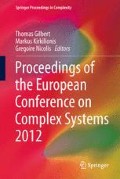Abstract
This paper describes an experimental application of the distance ratio measure used to compare individual networks among themselves and to analyze the aggregated network representing the group mental model from the field of emergency management.
The data was obtained by surveying a group of Civil Protection graduates and aggregating all the answers (shared mental model). The data allowed us to deepen the analysis of the resulting network in order to research for differences among networks.
Access this chapter
Tax calculation will be finalised at checkout
Purchases are for personal use only
Notes
- 1.
We recall that the Distance Ratio formula is adapted from systems dynamics where self-loops are a normal situation.
References
Butts CT (2009) Revisiting the foundations of network analysis. Science 325(5939):414–416
Newman MEJ (2003) The structure and function of complex networks. SIAM Rev 45(2):167
Boccaletti S, Latora V, Moreno Y, Chavez M, Hwang D (2006) Complex networks: structure and dynamics. Phys Rep 424(4–5):175–308
Dorogovtsev SN, Goltsev AV, Mendes JFF Critical phenomena in complex networks. Networks 1–79. doi:10.1103/RevModPhys.80.1275
Dorogovtsev SN, Mendes JF (2001) Language as an evolving word web. Proc - Royal Soc, Biol Sci 268(1485):2603–2606
Rubinov M, Sporns O (2010) NeuroImage complex network measures of brain connectivity: uses and interpretations. NeuroImage 52(3):1059–1069
Li W, Yang J-Y (2009) Comparing networks from a data analysis perspective. Complex Sci 5:1907–1916
Schaffernicht M, Groesser SN (2011) A comprehensive method for comparing mental models of dynamic systems. Eur J Oper Res 210(1):57–67
Langfield-Smith K, Wirth A (1998) Measuring differences between cognitive maps. J Oper Res Soc 43(12):1135–1150
Langan-Fox J (2001) Analyzing shared and team mental models. Int J Ind Ergon 28(2):99–112
Schaffernicht M (2006) Detecting and monitoring change in models. Syst Dyn Rev 22(1):73–88
Markóczy L, Goldberg J (1995) A method for eliciting and comparing causal maps. J Manag 21(2):305
Muñoz GJ, Glaze RM, Winfred Arthur J, Jarrett S, McDonald JN (2011) Driving mental models as a predictor of crashes and moving violations. In: 26th annual conference of the society for industrial and organizational psychology
Jones NA, Ross H, Lynam T, Perez P, Leitch A (2011) Mental models: an interdisciplinary synthesis of theory and methods. Ecol Soc 16(1). http://www.ecologyandsociety.org/vol16/iss1/art46/
Carley KM, Palmquist M (1992) Extracting, representing, and analysing mental models. Soc Forces 70(3):601–636
Kim MK (2012) Cross-validation study of methods and technologies to assess mental models in a complex problem solving situation. Comput Hum Behav 28(2):703–717
Sayama H, Farrell DL, Dionne SD (2010) The effects of mental model formation on group decision making: an agent-based simulation. Complexity 16(3):49–57
Kai Y, Qingquan W, Lili R (2008) Emergency Ontology construction in emergency decision support system. In: IEEE international conference on service operations and logistics, and informatics, vol 1, pp 801–805
Alexander D (2002) Principles of emergency planning and management. Oxford University Press, London, p 340
Griffin BD (2009) Emergency management terms and concepts. High Educ 1–8
Author information
Authors and Affiliations
Corresponding author
Editor information
Editors and Affiliations
Rights and permissions
Copyright information
© 2013 Springer International Publishing Switzerland
About this paper
Cite this paper
Caseiro, N., Trigo, P. (2013). Distance Ratio: An Exploratory Application to Compare Complex Networks. In: Gilbert, T., Kirkilionis, M., Nicolis, G. (eds) Proceedings of the European Conference on Complex Systems 2012. Springer Proceedings in Complexity. Springer, Cham. https://doi.org/10.1007/978-3-319-00395-5_19
Download citation
DOI: https://doi.org/10.1007/978-3-319-00395-5_19
Publisher Name: Springer, Cham
Print ISBN: 978-3-319-00394-8
Online ISBN: 978-3-319-00395-5
eBook Packages: Physics and AstronomyPhysics and Astronomy (R0)

